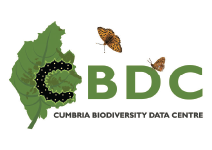Cumbria Bumblebee Atlas
Get Cumbria Buzzing - Bumblebee Atlas
The “Get Cumbria Buzzing” project is funded by the National Lottery Heritage Fund, and is a multi-partnership project. The aims of the project are far ranging but include key objectives to: Identify priority habitat fragmentation areas in Cumbria, carry out a range of outreach and education activities, carry out a range of habitat management, creation and restoration and – crucially, in the context of this publication – to clarify the status and distribution of bumblebees in the county through training, systematic surveys and transects (with subsequent records providing a “state of the moment” overview with comparison to historical data and relevant changes in land use and management – regionally and nationally). To this end, the project has here produced an Atlas of Bumblebees for the county, for which the main aim is to represent all recorded species in Cumbria and their distribution – based on records. As such, this includes the 20-21 extant species – those with recent or relatively recent records – and the two historically present but presumed (almost certainly) extinct species. The species accounts – following these introductory sections – will describe the species (general morphology and distinguishing features) and detail biology and ecology (life cycle and associated habitats). The status, distribution and future outlook of the species has been thoroughly researched and will be reviewed.
Atlas Interactive Map
Map Tools

Basemap - Heatmap

Now, you can start browsing the map by ticking species from the species layer list. By clicking on the species record symbol on the map you will get information on the species record and its location.
Acknowledgement
Many thanks to Steven Falk for permission to use his images of some of the species which we did not have access to – and for records and advice. Deepest thanks to Matt Miles and Blooms for Bees for permission to use the bee artworks. Many thanks to Mike Edwards, Stuart Roberts, Matt Smith and all involved at BWARS (Bees, Wasps and Ants Recording Society) for advice and information on many of the species involved and for suggested literature sources. And of course – last and by no means least – many thanks to all the recorders of bumblebees in Cumbria, past and present. In this respect, thanks to Tullie House Museum for providing support, resources and access to historic records. The great efforts of many past and present entomologists and natural history enthusiasts has provided a comprehensive overview of the historical status of bumblebees in Cumbria, despite considerable challenges presented by the size and terrain of the county, taxonomic difficulties and the simple fact that – historically at least – many entomologists did not tackle bumblebees with any enthusiasm (the reasons for which will be discussed in the next section). In the north of Cumbria, George B. Routledge and Frank H. Day provided a baseline of early records, with additional records from Harry Britten (who went on to become a very well-known entomologist and Curator of Entomology at Manchester Museum), and James Murray. In the south, James Davis Ward was a source of accurate records around Grange and Albert Edward Wright covered the same area with considerable effort until 1950.
The late, great, Neil Robinson was an aculeate specialist and not only recorded avidly and widely but also summarised the status and distribution of bumblebees (in addition to all aculeate bees, wasps and ants) in his “List of the bees, wasps and ants of Cumbria. Records to the year 2005”, which was – effectively – a Checklist / Atlas hybrid, such was the detail of aculeate species described. In more modern times, Stephen Hewitt (previously, Keeper of Natural Sciences at Tullie House Museum) and Michael Archer must be commended for continued recording of bumblebees as resident and visiting entomologists respectively. Vivian Russell, Jane Orgee, Carolyn Postlethwaite, Charlotte Rankin, Tanya St. Pierre, Nick Franklin and Ryan Clark have – in addition to working directly on this project – provided a huge number of records which has greatly increased and clarified the known status and distribution of bumblebees in Cumbria to the present day. Also, a great thanks to many colleagues from Lancashire WT and Cumbria WT (plus affiliated folk) who have kindly granted permission to use several photos throughout the Atlas.
This Bee Atlas has been produced by the Cumbria Biodiversity Data Centre and the ‘Get Cumbria Buzzing’ project, a Cumbria Local Nature Partnership project. Get Cumbria Buzzing was funded by the National Heritage Lottery Fund and National Highways.












